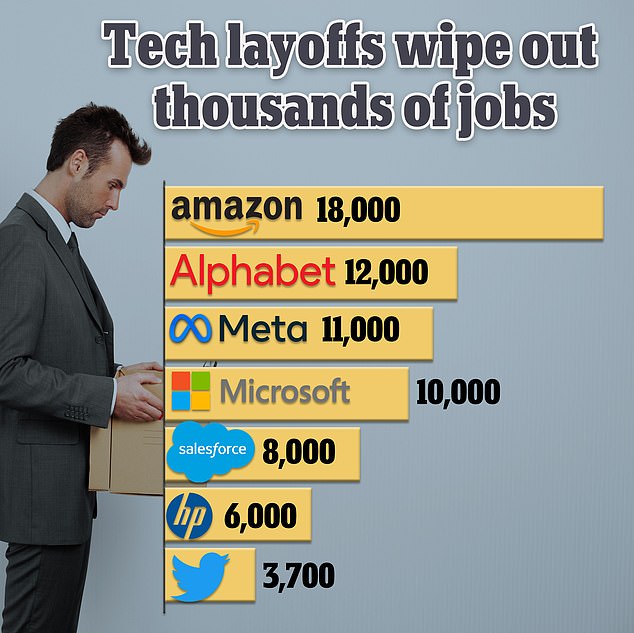Yahoo is set to lay off more than 20% of staff, including 1,000 THIS WEEK
>
Yahoo has become the latest tech giant to announce mass layoffs as it works to restructure its ad tech division.
The company announced Thursday that it plans to lay off more than 20 percent of its total workforce, which will affect nearly half of Yahoo’s ad-tech employees by the end of the year, including nearly 1,000 employees this week.
Executive Director Jim Lanzone said Axios the layoffs are not due to financial problems, but to strategic changes at the company’s Yahoo for Business advertising unit, which it says is unprofitable.
The move comes as many advertisers have cut their marketing budgets in response to record inflation rates and continued uncertainty about a recession.
With Thursday’s announcement, Yahoo is just the latest in a series of technology companies to announce layoffs, cutting thousands of jobs that pay a total of $12 billion a year.
Yahoo CEO Jim Lanzone announced Thursday that the company will lay off more than 20 percent of its staff as it restructures its advertising unit.

The job cuts will affect nearly half of Yahoo’s ad tech employees by the end of the year, including nearly 1,000 employees this week.
Yahoo was bought by private equity firm Apollo Global Management for $5 billion in 2021, along with longtime rival AOL.
Combined, Axios reports, the two companies made more than 30 ad-tech acquisitions dating back more than a decade when Verizon acquired the two companies in 2015 and 2017, respectively.
Verizon hoped to leverage the massive data sets of the two companies and their acquired ad-tech businesses to create a unified digital advertising platform that could compete with Google or Meta (then Facebook).
But that dream never materialized, Lanzone said, adding: ‘A lot of resources were going into that unified pile of no return.
“This was a long-standing problem with every variation of this company…that needed to be resolved over time.”
Under Lanzone’s leadership, the company will now shut down a part of its advertising business called SSP, or supply-side platform, which helps digital publishers sell automated ads across a variety of platforms.
It will also shut down its native advertising platform, called Gemini, and instead leverage its newly formed partnership with advertising giant Taboola to sell native advertising on its own platforms.
By doing so, Lanzone said, Yahoo will be able to increase the number of advertisers competing for ad placement on Yahoo’s properties eight times.
At the same time, Yahoo will double down on part of its ad business called DSP, or demand-side platform, which helps advertisers buy ads automatically across various websites.
The company will streamline that business to focus on selling advertisers to Fortune 500 companies and premium accounts, Lanzone said.
To do so, Yahoo will create a premium ad sales team for Yahoo owned and operated properties such as Yahoo Sports, Yahoo News, Yahoo Mail and Yahoo Finance.
The new company will be called Yahoo Advertising.
“The moves are meant to simplify and strengthen the good parts of the business, while ending the rest,” Lanzone said.

At just seven big tech companies, job cuts announced in recent months total nearly 70,000: Amazon, Alphabet, Meta, Microsoft, Salesforce, HP and Twitter.

Using the median salaries reported by those companies in regulatory filings, most of which are from 2021, DailyMail.com estimates the combined annual salaries for the eliminated jobs to be about $11.95 billion.
Recent tech layoffs have hit highly-paid skilled workers the hardest, as companies that boomed during the pandemic had to cut costs to prepare for an economic slowdown.
Technology-driven companies laid off more than 150,000 workers last year, according to a recently published analysis by Layoffs.fyi, which tracks layoffs in real time through information collected from company and press releases.
At just seven big tech companies, job cuts announced in recent months totaled nearly 70,000: Amazon, Alphabet, Meta, Microsoft, Salesforce, HP and Twitter.
Using the median salaries reported by those companies in regulatory filings, most of which are from 2021, DailyMail.com estimates the combined annual salaries for the eliminated jobs to be about $11.95 billion.
That figure doesn’t take into account the fact that Amazon, which has a large logistics workforce and a median salary of just $29,007, has focused primarily on higher-paying corporate positions in its total announced cuts of 18,000 workers.
It also doesn’t include the thousands of jobs that have been cut at smaller tech companies that aren’t household names.
For laid-off tech workers, though, the news isn’t all bad, as data shows most of them are getting new jobs relatively quickly after losing their jobs.
Nearly 40 percent of previously laid off tech workers found work less than a month after they started looking, ZipRecruiter found in a recent survey.
“Despite widespread layoffs, hiring freezes and cost cuts taking place in tech, many tech workers are finding new employment remarkably quickly,” Julia Pollak, chief economist at ZipRecruiter, told The Associated Press. Wall Street Journal.
“They continue to be the most sought-after workers with the most in-demand skills,” he argued.
At the same time, blue-collar workers are also in high demand and have seen their wages rise at a faster rate than those of the top earners.
In November, wages in the bottom quartile of wage earners rose 7.4 percent from a year earlier, outpacing inflation, while wages in the top quartile rose just 4.8 percent.
